Calixtlahuaca on:
[Wikipedia]
[Google]
[Amazon]
Calixtlahuaca (from the Nahuatl, where calli means "house", and ixtlahuatl means "prairie" or "plains", hence the translation would be "plains-house-place") is a Postclassic period

 Archaeologist José García Payón excavated the monumental
Archaeologist José García Payón excavated the monumental
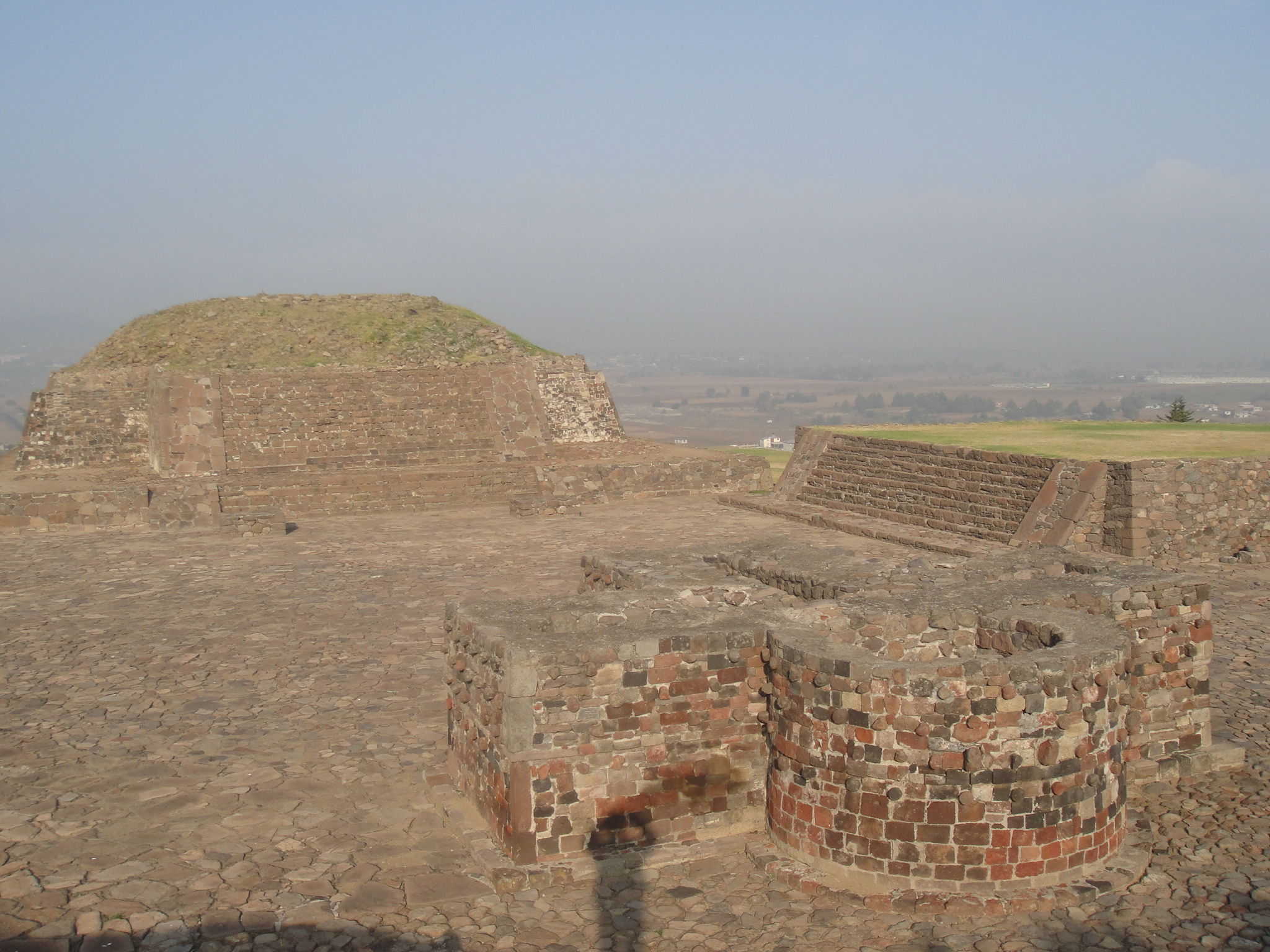
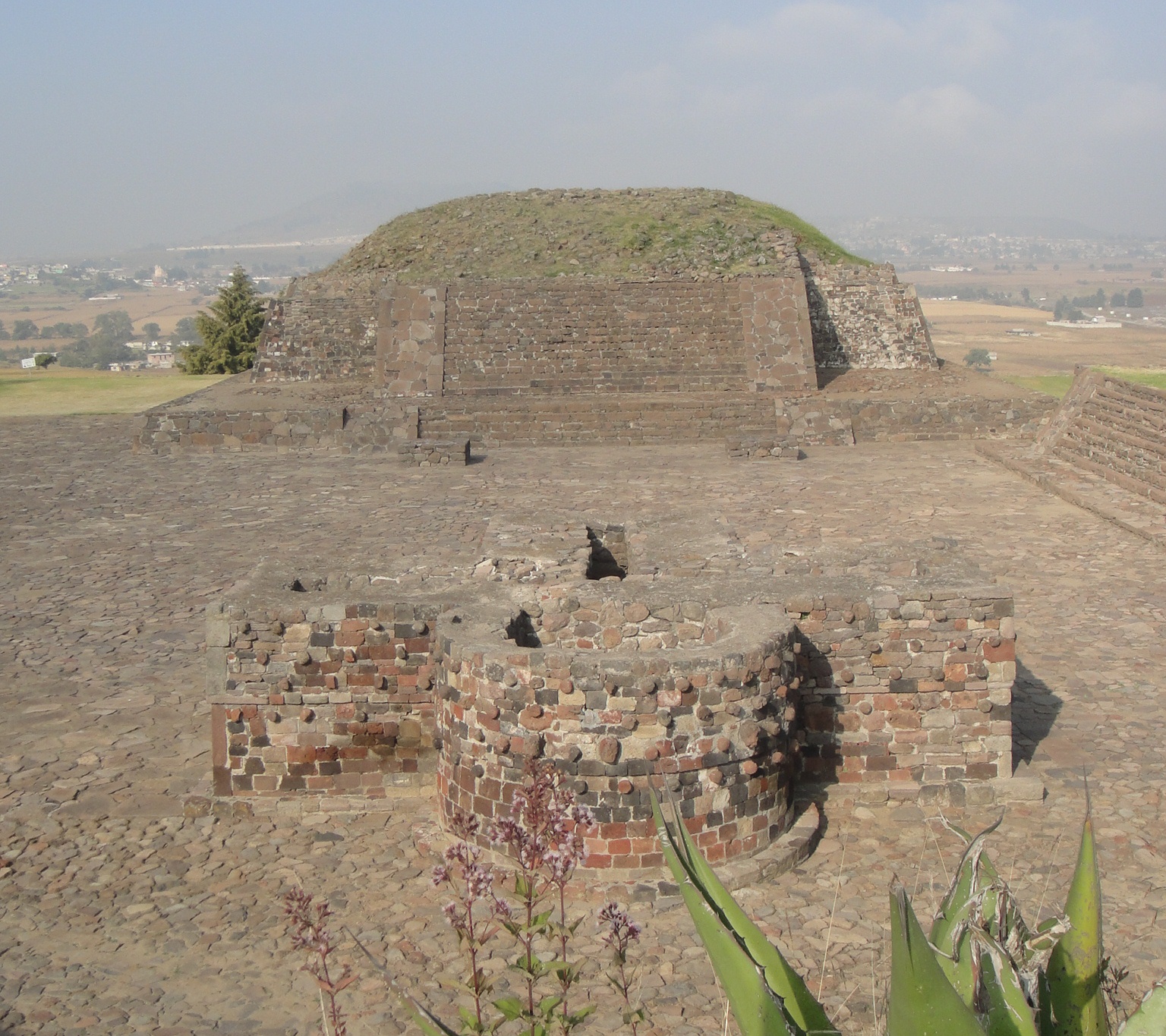 Quetzalcoatl Temple probably dedicated to Ehécatl. Mesoamerican round buildings, are generally related Ehécatl. The circle is a perfect geometric figure, has no beginning or end, therefore infinite, as the gods.
It is a circular building; Probably the most important building in the site, which was apparently dedicated to the cult of Quetzalcoatl, represented as a male individual wearing sandals and mouth mask resembling a bird beak.
It is a large circular temple with four construction stages. García Payon excavated the sculpture of a priest with a mask of the God
Quetzalcoatl Temple probably dedicated to Ehécatl. Mesoamerican round buildings, are generally related Ehécatl. The circle is a perfect geometric figure, has no beginning or end, therefore infinite, as the gods.
It is a circular building; Probably the most important building in the site, which was apparently dedicated to the cult of Quetzalcoatl, represented as a male individual wearing sandals and mouth mask resembling a bird beak.
It is a large circular temple with four construction stages. García Payon excavated the sculpture of a priest with a mask of the God

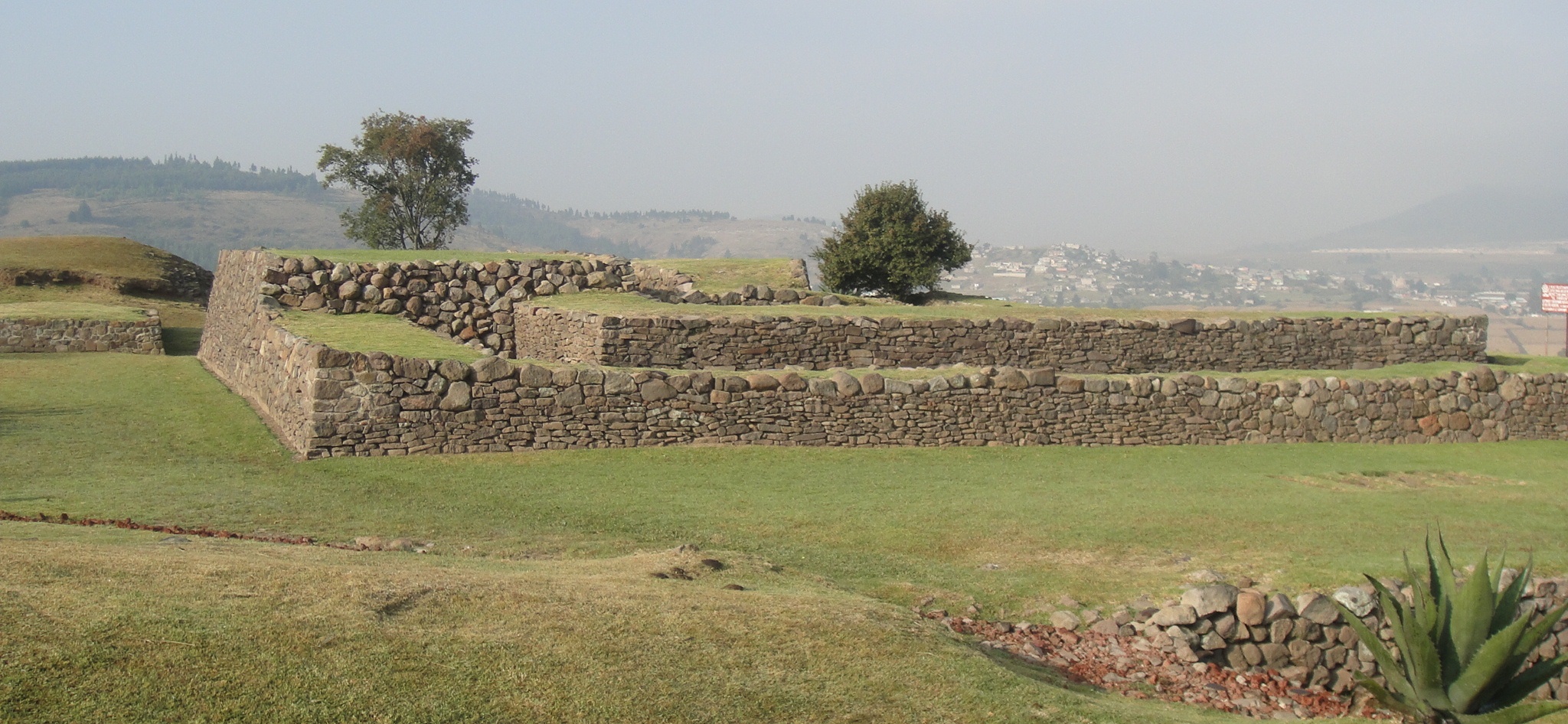 Also called the Pantheon, approximately 50 human burials were found here with offerings (gold, ceramic, rocks of obsidian, and arrowheads.) These structures were built on a large terrace and there are remains of seven bases on the West side.
It was restored between 2002 and 2004, personally by Mr. Alejandro Javier Hernandez, approved by INAH technical direction, but without any support or assistance.
East of the main structure, is a hallway (south-north) at the southeast corner, it contains embedded three petroglyphs (see below gallery with composite pictures of petroglyphs).
Also called the Pantheon, approximately 50 human burials were found here with offerings (gold, ceramic, rocks of obsidian, and arrowheads.) These structures were built on a large terrace and there are remains of seven bases on the West side.
It was restored between 2002 and 2004, personally by Mr. Alejandro Javier Hernandez, approved by INAH technical direction, but without any support or assistance.
East of the main structure, is a hallway (south-north) at the southeast corner, it contains embedded three petroglyphs (see below gallery with composite pictures of petroglyphs).
 Not explored, located higher up on the hill side.
Not explored, located higher up on the hill side.
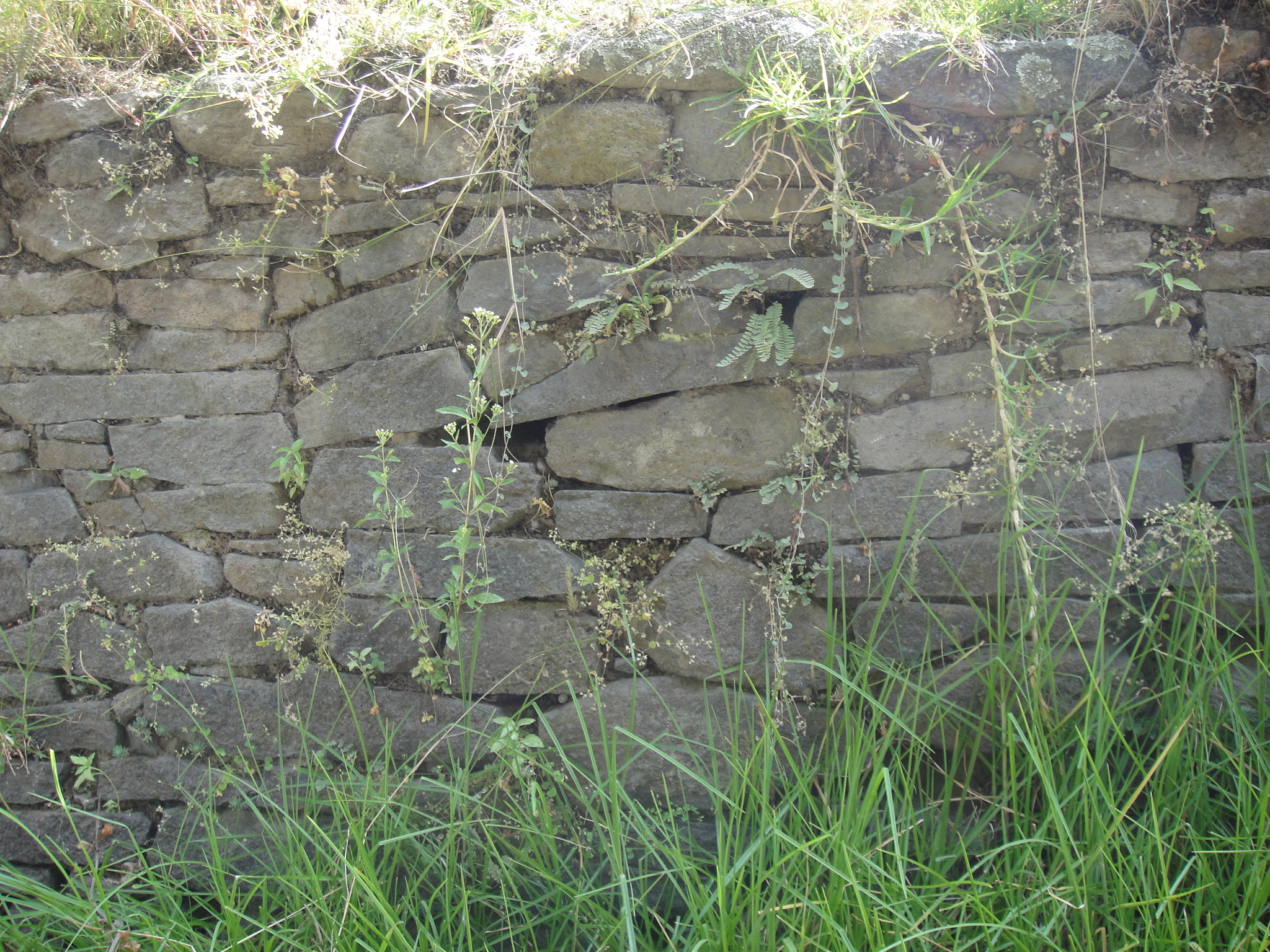
 Comprises remains of a large basement, about 85 meters wide by 100 long, García Payon found an engraved round stone with a hole in the Center, similar to those embedded at ballgame courts, he assumed it was one, there has not been any further exploration, it is located approximately 500 North of Temple 3, within the urban area.
Comprises remains of a large basement, about 85 meters wide by 100 long, García Payon found an engraved round stone with a hole in the Center, similar to those embedded at ballgame courts, he assumed it was one, there has not been any further exploration, it is located approximately 500 North of Temple 3, within the urban area.

 Monumento 17 is in reality a complex. Although García Payón identified it as a "Calmecac" (school and priests residence), is much more likely it actually was the Royal Palace in the city. It has the same type of other Aztec palaces (Evans 2004; Smith 2005a).
Altogether it has 32 rooms, an original adobe wall, and three different stages of construction. It has interior corridors and access stairs to different levels.
To the visitor eyes, the complex can be divided into four main parts, a residential area on the south side of the complex, a ceremonial area with a temple or main basement, a wide plaza in front and bases on the West side area.
Monumento 17 is in reality a complex. Although García Payón identified it as a "Calmecac" (school and priests residence), is much more likely it actually was the Royal Palace in the city. It has the same type of other Aztec palaces (Evans 2004; Smith 2005a).
Altogether it has 32 rooms, an original adobe wall, and three different stages of construction. It has interior corridors and access stairs to different levels.
To the visitor eyes, the complex can be divided into four main parts, a residential area on the south side of the complex, a ceremonial area with a temple or main basement, a wide plaza in front and bases on the West side area.

 This area can be subdivided into two sub-areas, divided (east and west) by the adobe wall, it is believed to have been built during the last Mexica occupation, in the late postclassical period.
It has three entrances, one from the West, with communication corridors to the various areas and access to the private housing compound, which has a series of rooms around an internal private patio. This area has another access from the southeast corner of the site. A third entrance provides northern access, to the ceremonial area or the main square.
This area can be subdivided into two sub-areas, divided (east and west) by the adobe wall, it is believed to have been built during the last Mexica occupation, in the late postclassical period.
It has three entrances, one from the West, with communication corridors to the various areas and access to the private housing compound, which has a series of rooms around an internal private patio. This area has another access from the southeast corner of the site. A third entrance provides northern access, to the ceremonial area or the main square.

 Probably the royal residence of the main city governor, consists of 7 rooms around a private patio and private access, also possibly guards rooms. The rooms are of different sizes and certainly different uses.
Probably the royal residence of the main city governor, consists of 7 rooms around a private patio and private access, also possibly guards rooms. The rooms are of different sizes and certainly different uses.

 On the west side of the plaza, in front of the main temple, is a series of basements, with remains of constructions, a stair called “K” by García Payón and two beautiful slope-panel constructions, Teotihuacan style.
On the west side of the plaza, in front of the main temple, is a series of basements, with remains of constructions, a stair called “K” by García Payón and two beautiful slope-panel constructions, Teotihuacan style.
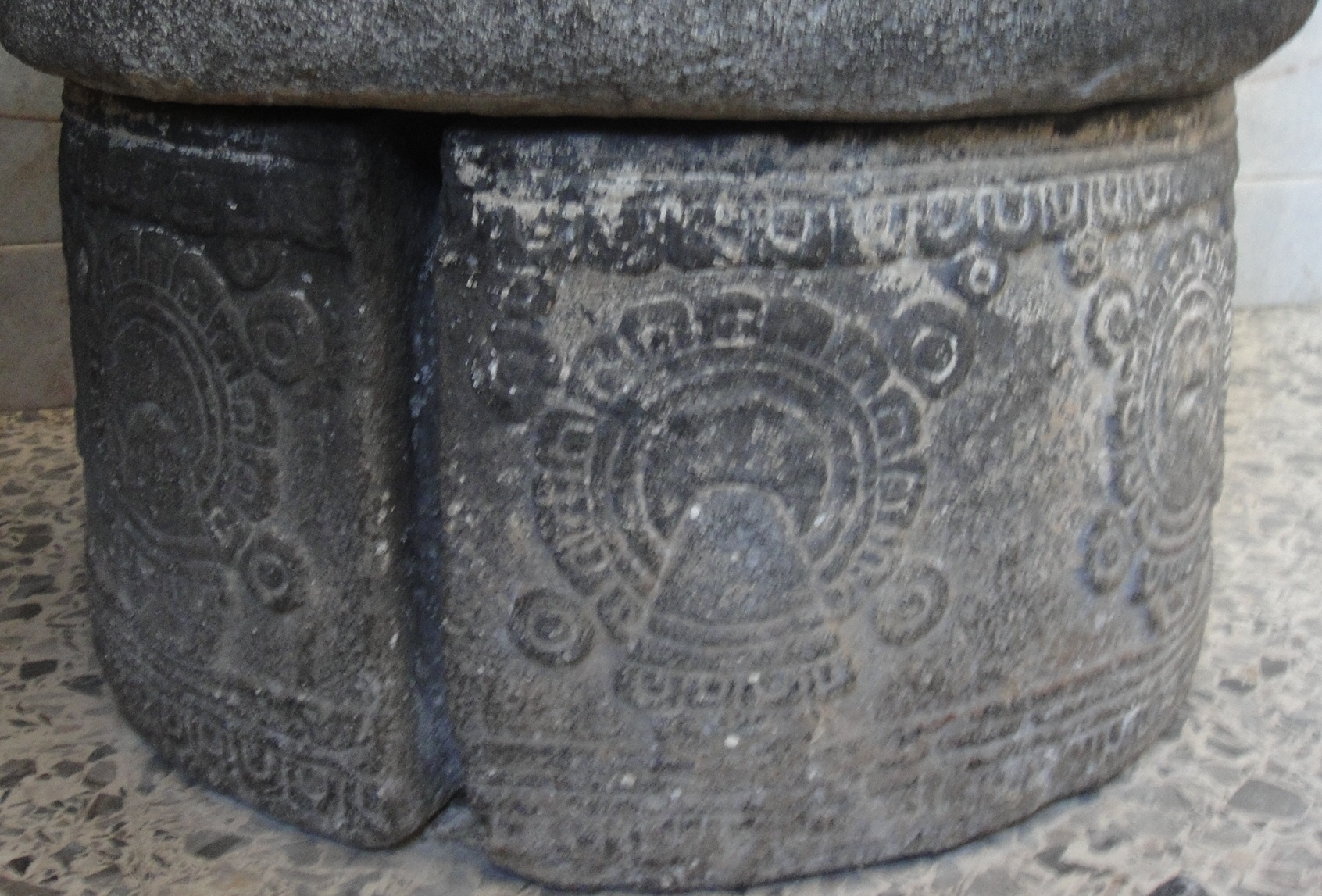 There were two similar stones, one with a concave top, is located in the parish of St. Francis of Assisi in Calixtlahuaca. The other with a flat top is at the Toluca Museum.
There were two similar stones, one with a concave top, is located in the parish of St. Francis of Assisi in Calixtlahuaca. The other with a flat top is at the Toluca Museum.
File: Calixtlahuaca petroglifo 5.JPG
File:Petroglifo_6.JPG
File:Petroglifo_7.JPG
File:Petroglifo_8.JPG
File:Petroglifo_9.JPG
File:Petroglifo_10-11.JPG
File:Petroglifo 10.JPG
File:Petroglifo_13.JPG
File: Petroglifo 14-15.jpg
File:Petroglifos en parroquia.jpg
Postclassic Urbanism at Calixtlahuaca: Reconstructing the Unpublished Excavations of José García Payón.
*Smith, Michael E. (2005)
accessed January 2008. *Smith, Michael E., Juliana Novic, Peter C. Kroefges, and Angela Huster (2007)
* Smith, Michael E., Jennifer Wharton, and Melissa McCarron (2003)
Las ofrendas de Calixtlahuaca
in ''Expresión Antropológica'' 19:35-53.
Calixtlahuaca Archaeological Project Blog
Calixtlahuaca: A brief Guide to the site. Dr. Michael E. Smith, Arizona State University. 2006.
{{coord, 19, 20, N, 99, 41, W, display=title, region:MX_type:city_source:GNS-enwiki Archaeological sites in Mexico Mesoamerican sites Archaeological sites in the State of Mexico Aztec sites Former populated places in Mexico Tourist attractions in the State of Mexico Toluca 1930s archaeological discoveries
Mesoamerica
Mesoamerica is a historical region and cultural area in southern North America and most of Central America. It extends from approximately central Mexico through Belize, Guatemala, El Salvador, Honduras, Nicaragua, and northern Costa Rica ...
n archaeological site
An archaeological site is a place (or group of physical sites) in which evidence of past activity is preserved (either prehistoric or historic or contemporary), and which has been, or may be, investigated using the discipline of archaeology a ...
, located near the present-day city
A city is a human settlement of notable size.Goodall, B. (1987) ''The Penguin Dictionary of Human Geography''. London: Penguin.Kuper, A. and Kuper, J., eds (1996) ''The Social Science Encyclopedia''. 2nd edition. London: Routledge. It can be def ...
of Toluca
Toluca , officially Toluca de Lerdo , is the state capital of the State of Mexico as well as the seat of the Municipality of Toluca. With a population of 910,608 as of the 2020 census, Toluca is the fifth most populous city in Mexico. The city f ...
in the State of Mexico. Known originally as "Matlatzinco", this urban
Urban means "related to a city". In that sense, the term may refer to:
* Urban area, geographical area distinct from rural areas
* Urban culture, the culture of towns and cities
Urban may also refer to:
General
* Urban (name), a list of people ...
settlement was a powerful capital whose kings controlled a large territory in the Toluca Valley
The Toluca Valley is a valley in central Mexico, just west of the Valley of Mexico (Mexico City), the old name was Matlatzinco. The valley runs north–south for about , surrounded by mountains, the most imposing of which is the Nevado de Toluca Vo ...
.
Background
architecture
Architecture is the art and technique of designing and building, as distinguished from the skills associated with construction. It is both the process and the product of sketching, conceiving, planning, designing, and constructing building ...
at Calixtlahuaca in the 1930s and restored a number of temple
A temple (from the Latin ) is a building reserved for spiritual rituals and activities such as prayer and sacrifice. Religions which erect temples include Christianity (whose temples are typically called churches), Hinduism (whose temples ...
s and other buildings. Most notable are Structure 3, a circular temple dedicated to the Aztec wind god Ehecatl
Ehecatl ( nci-IPA, Ehēcatl, eʔˈeːkatɬ, ) is a pre-Columbian deity associated with the wind, who features in Aztec mythology and the mythologies of other cultures from the central Mexico region of Mesoamerica. He is most usually interpreted a ...
, and Structure 17, a large royal “palace”. The architecture and stone sculpture
Sculpture is the branch of the visual arts that operates in three dimensions. Sculpture is the three-dimensional art work which is physically presented in the dimensions of height, width and depth. It is one of the plastic arts. Durable ...
at the site is similar to that of other Middle to Late Postclassic period (AD 1100-1520) Aztec sites in central Mexico
Mexico (Spanish: México), officially the United Mexican States, is a country in the southern portion of North America. It is bordered to the north by the United States; to the south and west by the Pacific Ocean; to the southeast by Guatema ...
.
In 1930, the preserved area of site had an extension of 144 hectares, today it only has 116.
Between 1988 and 1998, some projects have been implemented to preserve and protect the site contents. These projects included drainage requirements, leveling of some areas, signaling, site regulations, and protection against urban growth.
In 1998, archeologist Jorge Villanueva Villalpando restored the south wall of the eastern facade of Building III, which was damaged by constant and strong storms.
In 2002 Dr. Michael E. Smith initiated a new research project at Calixtlahuaca. This project was sponsored by Arizona State University and the National Science Foundation
The National Science Foundation (NSF) is an independent agency of the United States government that supports fundamental research and education in all the non-medical fields of science and engineering. Its medical counterpart is the National ...
, and fieldwork began in 2006 with a full-coverage intensive survey of the site. In 2007 a series of houses and terraces were excavated, revealing the form of life of the inhabitants of Calixtlahuaca for the first time.
Inhabitants
It is believed that the initial settlers of this region were nomadic natives who used to visit seasonally. Lázaro Manuel Muñoz (over 200 years ago), stated that the Matlatzincas, or their nomad ancestors, visited this site at least 640 BCE (a theory appears consistent withLorenzo Boturini
Lorenzo Boturini Benaducci (also Botterini) 1698, Como, Sondrio, Italy – 1749, Madrid) was a historian, antiquary and ethnographer of New Spain, the Spanish Empire, Spanish Empire's colonial dominions in North America.
Early life
Born in It ...
) and that Otomi
The Otomi (; es, Otomí ) are an indigenous people of Mexico inhabiting the central Mexican Plateau (Altiplano) region.
The Otomi are an indigenous people of Mexico who inhabit a discontinuous territory in central Mexico. They are linguisticall ...
hunter-gatherer groups were present 3,000 years ago at the now dried up lake, which was fed by melting water from Nevado de Toluca. Subsequently, the Matlatzinca arrived and founded a small settlement which became under eventual Toltec
The Toltec culture () was a pre-Columbian Mesoamerican culture that ruled a state centered in Tula, Hidalgo, Mexico, during the Epiclassic and the early Post-Classic period of Mesoamerican chronology, reaching prominence from 950 to 1150 CE. T ...
cultural influence. It is also believed that the Matlatzinca ethnic group belonged to the Nahua
The Nahuas () are a group of the indigenous people of Mexico, El Salvador, Guatemala, Honduras, and Nicaragua. They comprise the largest indigenous group in Mexico and second largest in El Salvador. The Mexica (Aztecs) were of Nahua ethnicity, a ...
family that had previously invaded the territory.
The town of Tecaxic was conquered by the mexicas and became dominated by the Aztecs at about 1476 AD., during the reign of Tlatoani
''Tlatoani'' ( , "one who speaks, ruler"; plural ' or tlatoque) is the Classical Nahuatl term for the ruler of an , a pre-Hispanic state. It is the noun form of the verb "tlahtoa" meaning "speak, command, rule". As a result, it has been variousl ...
Axayacatl
Axayacatl (; nci, āxāyacatl ; es, Axayácatl ; meaning "face of water"; –1481) was the sixth of the of Tenochtitlan and Emperor of the Aztec Triple Alliance.
Biography
Early life and background
Axayacatl was a son of the princess Ato ...
. As the city was destroyed, the Aztecs built a new city that was then called Calixtlahuaca.
In 1510, the Matlatzinca tried to end the Aztec tutelage and Moctezuma II immediately ordered the city destroyed and the inhabitants fled west towards Michoacán. Later, the city was repopulated by various groups, which concentrated on agriculture, farming and animal husbandry. Among the municipalities formed were Tollocan, Tenancingo, Ocuilan, Calimaya
Calimaya is a town and municipality located just south of Toluca, the capital of the State of Mexico in central Mexico. The settlement was probably established around 800 BCE, when the city of Teotenango was in existence. It remained an importa ...
and Tepemaxalco, the latter being the most important.
Invasions
The Matlatzinca lands were considered a corn producing region, and this may have been the main reason for the continued invasions from the epiclassical period, first by theToltec
The Toltec culture () was a pre-Columbian Mesoamerican culture that ruled a state centered in Tula, Hidalgo, Mexico, during the Epiclassic and the early Post-Classic period of Mesoamerican chronology, reaching prominence from 950 to 1150 CE. T ...
s and subsequently by Chālcah (confederacies) in the 12th century. The region was divided into three Altepetls, two of which were prepared to remain independent and possibly associate with the Purépechas of Michoacán, but a third Altepetl ( Tollocan), wanted an association with the Aztecs. This division prompted the Matlatzinca migration to other regions, such as Tiripitío, Andarapeo, Huetamo Huetamo is a municipality in the southeastern corner of the Mexican state of Michoacán, in a region known as "Tierra Caliente" (meaning hot land). Of indigenous Purepecha Indian origin, the word "Huetamo" means "four chiefs" or "four came". The mu ...
, Charo
María Rosario Pilar Martínez Molina Baeza, professionally known by her stage name Charo, is a Spanish-American actress, singer, comedian, and flamenco guitarist.
Charo began playing guitar at the age of nine and trained under the famed A ...
and Undameo, among others.
Axayacatl
Axayacatl (; nci, āxāyacatl ; es, Axayácatl ; meaning "face of water"; –1481) was the sixth of the of Tenochtitlan and Emperor of the Aztec Triple Alliance.
Biography
Early life and background
Axayacatl was a son of the princess Ato ...
, the Tenochtitlan
, ; es, Tenochtitlan also known as Mexico-Tenochtitlan, ; es, México-Tenochtitlan was a large Mexican in what is now the historic center of Mexico City. The exact date of the founding of the city is unclear. The date 13 March 1325 was ...
Huey Tlatoani
''Tlatoani'' ( , "one who speaks, ruler"; plural ' or tlatoque) is the Classical Nahuatl term for the ruler of an , a pre-Hispanic state. It is the noun form of the verb "tlahtoa" meaning "speak, command, rule". As a result, it has been variousl ...
(1469-1481) fought against Cuextapalin, a Mazatleca general, whose slingshot stuck Axayacatl in the leg (causing a lifetime injury), and tried to take him prisoner unsuccessfully. Later, the Aztecs returned with their Tollocan allies and fought against Matlatzinca in 1474, taking 11,070 prisoners to be sacrificed in Tenochtitlan, thus preventing further uprisings in the region, as well as resettling Nahua families to Calixtlahuaca.
From 1482 to 1484, there was another attempted Matlatzinca rebellion, but Tizoc destroyed the Calixtlahuaca temples, marking his victory on a stone. The last rebellion attempt occurred in 1510, and the Aztec Tlatoani Montezuma II, ordered the destruction of the area, which led to the emigration of its inhabitants to Michoacán.
Occupation periods
As a result of some of the investigations performed, the following occupation periods have been interpreted and established: *Preclassical Period (1500 – 200 BC) Small clay heads type A, B, C, D & F, as well as vertical walls tied with mud as part of the constructive system of terraces in the middle of the Tenismo hill, where some housing units were located. (Probably Otomi groups.) *Classical Period (300 – 600 AD) Ceramic belonging to the Teotihuacán third classic period, and first stage of building III, which was damaged during the 1475 earthquake. (Teotihuacan Groups.) *Epiclassical period (900 – 1200 AD) Toltec influence with the increased construction of terraces on slopes and some buildings. (Toltec Groups.) *Postclassical Period (1200 – 1510 AD) Distinguished by a Matlatzinca near hegemony that is limited by the Aztec influence. (Matlatzincas Groups and eventually Mexicas.)Site
The Postclassic site extended approximately 264 hectares, covering portions of the valley floor, the majority of the Cerro Tenismo hill, and portions of a smaller hill to the east. All of the major monumental architecture at the site was built during this period. Unlike many Postclassic Mesoamerican cities, which usually have a single central group of monumental architecture, the large structures at Calixtlahuaca are split into multiple smaller architectural groups scattered from the valley floor to the summit of the hill. The areas between the monumental groups were filled in with a mixture of commoner houses and agricultural terraces. This archaeological site is located at about 2,500 meters, the Cerro Tenismo summit is at 2,975 meter above sea level. At top of the cerro is a “Stone” water spring, called Pinalinchini. Main Structures:Monument 1
Located within the urban zone of the town Calixtlahuaca.Monument 2
Yet to be explored by INAH.Monument 3
Ehecatl
Ehecatl ( nci-IPA, Ehēcatl, eʔˈeːkatɬ, ) is a pre-Columbian deity associated with the wind, who features in Aztec mythology and the mythologies of other cultures from the central Mexico region of Mesoamerica. He is most usually interpreted a ...
. This object is one of the best-known sculptures of the Mexica style (Matos Moctezuma and Solis Olguín 2002).
The statue was discovered by chance, during Payón explorations, in his absence, a group of workers saw two large lizards go into a group of stones, the workers removed the stones, found the statue and removed it, and this got Payón upset. One of the workers (Joaquin Alvarez), took one arm, which he later returned.
Monument 4
The temple is located within a large plaza, with a single stairway. It forms part of a group in a plaza, with a cross altar decorated with skulls, or mesoamerican tzompantli. At the north side of the plaza is another structure.Tzompantli
This cross altar, had skulls carved in stone embedded around the structure. Originally had more than ten, today there are only two original and the replica of a third, this structure was explored in 1940 by the Guatemalan Archaeologist Carlos Navarrete.Monument 5 and 7

Monument 10 and 11
 Not explored, located higher up on the hill side.
Not explored, located higher up on the hill side.
Monument 13, 14 and 15
Not explored, located higher up on the hill side.Monument 16
Monument 17
Residential area
 This area can be subdivided into two sub-areas, divided (east and west) by the adobe wall, it is believed to have been built during the last Mexica occupation, in the late postclassical period.
It has three entrances, one from the West, with communication corridors to the various areas and access to the private housing compound, which has a series of rooms around an internal private patio. This area has another access from the southeast corner of the site. A third entrance provides northern access, to the ceremonial area or the main square.
This area can be subdivided into two sub-areas, divided (east and west) by the adobe wall, it is believed to have been built during the last Mexica occupation, in the late postclassical period.
It has three entrances, one from the West, with communication corridors to the various areas and access to the private housing compound, which has a series of rooms around an internal private patio. This area has another access from the southeast corner of the site. A third entrance provides northern access, to the ceremonial area or the main square.
Rooms
The main features of all rooms are: All rooms had stuccoed floors, built over gravel placed on a compacted fill surface, see photographs. Every room had a square sunken hole, with charcoal remains, that probably were used for heating, cooking or burning ritualCopal
Copal is tree resin, particularly the aromatic resins from the copal tree ''Protium copal'' (Burseraceae) used by the cultures of pre-Columbian Mesoamerica as ceremonially burned incense and for other purposes. More generally, copal includes re ...
.
Private quarters
 Probably the royal residence of the main city governor, consists of 7 rooms around a private patio and private access, also possibly guards rooms. The rooms are of different sizes and certainly different uses.
Probably the royal residence of the main city governor, consists of 7 rooms around a private patio and private access, also possibly guards rooms. The rooms are of different sizes and certainly different uses.
Main temple
This basement has a ceremonial plaza characteristics, has three stairways to access the top, divided by smooth slopped wall sections (alfardas). The Center, without a doubt the most important access is approximately 10 meters wide, lateral stairways are 6 meters. It is thought that there were at least three temples at the top. Remains of a stuccoed floor can be seen on top. This building has a "Probe" or exploration entrance made by archaeologists on the north side, showing three constructive stages. (See Picture) It has been confirmed in this temple, that there are no secret chambers or tombs, as is normal in similar temples in the Mexico Highlands.Western side structures
Objects found
García Payón excavated burials containing ceramic, very similar to vessels from several Teotihuacan stages. Also there is a group of Oaxaca vessels; five shaped as jaguar paw, another with a Zapotec glyph, some are made with the characteristic gray clay of that region, belonging to the Xoo Phase, or Monte Albán IIIb/IV, in the Oaxaca Valley (Caso, et al. 1967; Martínez López, et al. 2000). The presences of these materials confirm the importance of trade practices within these regions, during the Classical and Postclassical periods (Smith y Lind 2005).Ceramic
The largest ceramic objects group is “Malacates”, and more than 50% of these are large Malacates, used for spinning maguey fiber. Among figurines, three groups were identified: *Objects in the style of the Aztec figurines of Valley Mexico and Morelos (Leonard 1950; Cook Smith 2005b), but with different paste (probably local paste of the Toluca Valley) *Objects in the style of the figurines Aztecs, with the typical Orange paste used in the Valley of Mexico (imported); *Figurines resembling Postclassical figures, unclassified, it is assumed to be local styles, yet to be identified. The presence of these three categories is also noted in the Postclassical Yautepec figurines (Smith 2005b).Polished and carved lithic
There are 32 maguey de-fibers. Oto-Pame (Folan 1989; Ohi 1975; Parsons y Parsons 1990). Also there are multiple objects as hands and stone boxes. De-fibers are common in Postclassical period burials in the Toluca Valley (Carbajal Correa and Gonzalez Miranda 2003;) Ohi 1975; Zúñiga Bárcenas 2001). There are only 20 carved lithic artifacts, made of Flint and Obsidian.Copper/bronze
There are 81 copper objects; it is one of the largest Collections outside the territory of thePurépecha Empire
The Purépecha Empire, also known by the term Iréchikwa, was a polity in pre-Columbian Mexico. Its territory roughly covered the geographic area of the present-day Mexican state of Michoacán, as well as parts of Guanajuato, Guerrero, and Ja ...
. Other Calixtlahuaca copper objects exist in the United States, for example, the American Museum of Natural History in New York City. Most are rattles, and their forms resemble objects cast in bronze at the Postclassical period in the West and the Center of Mexico (Hosler 1994).
Beads
There are 366 green glass beads in the collection and 23 shells objects with holes.Stone sculptures
The Ehécatl sculpture is well known everywhere. Also known is the Chalchiuhtlicue goddess figure, currently exhibited at National Museum of anthropology of Mexico City, I the Aztec room. But a fact not well known is that there is a large collection (275 pieces) of Calixtlahuaca stone sculptures. Many are the Mexica style, and others (including a large group of reliefs) are of a different style, probably a Toluca Valley local style.Sacrificial stone
Petroglyphs
For the St. Francis of Assisi parish construction in the town of Calixtlahuaca, undetermined number of stones, from the archaeological site were used, some engraved stones can be seen at the church exterior walls, see the below Gallery.Gallery
Calixtlahuaca head
Calixtlahuaca is also known for the discovery of aceramic
A ceramic is any of the various hard, brittle, heat-resistant and corrosion-resistant materials made by shaping and then firing an inorganic, nonmetallic material, such as clay, at a high temperature. Common examples are earthenware, porcelain ...
dubbed the " Tecaxic-Calixtlahuaca head" uncovered during García Payón's excavations in the 1930s and purported to be from Ancient Rome
In modern historiography, ancient Rome refers to Roman civilisation from the founding of the city of Rome in the 8th century BC to the collapse of the Western Roman Empire in the 5th century AD. It encompasses the Roman Kingdom (753–509 BC ...
. Although this artifact has a provenance similar to other items excavated at that time – and radioluminescence
Radioluminescence is the phenomenon by which light is produced in a material by bombardment with ionizing radiation such as alpha particles, beta particles, or gamma rays. Radioluminescence is used as a low level light source for night illumi ...
testing and stylistic analysis seem to support the antiquity of the artifact – mainstream Mesoamerican scholars to remain skeptical.See Smith (2005).
Notes
References
* *Smith, Michael E. (2003Postclassic Urbanism at Calixtlahuaca: Reconstructing the Unpublished Excavations of José García Payón.
*Smith, Michael E. (2005)
accessed January 2008. *Smith, Michael E., Juliana Novic, Peter C. Kroefges, and Angela Huster (2007)
* Smith, Michael E., Jennifer Wharton, and Melissa McCarron (2003)
Las ofrendas de Calixtlahuaca
in ''Expresión Antropológica'' 19:35-53.
External links
Calixtlahuaca Archaeological Project Blog
Calixtlahuaca: A brief Guide to the site. Dr. Michael E. Smith, Arizona State University. 2006.
{{coord, 19, 20, N, 99, 41, W, display=title, region:MX_type:city_source:GNS-enwiki Archaeological sites in Mexico Mesoamerican sites Archaeological sites in the State of Mexico Aztec sites Former populated places in Mexico Tourist attractions in the State of Mexico Toluca 1930s archaeological discoveries